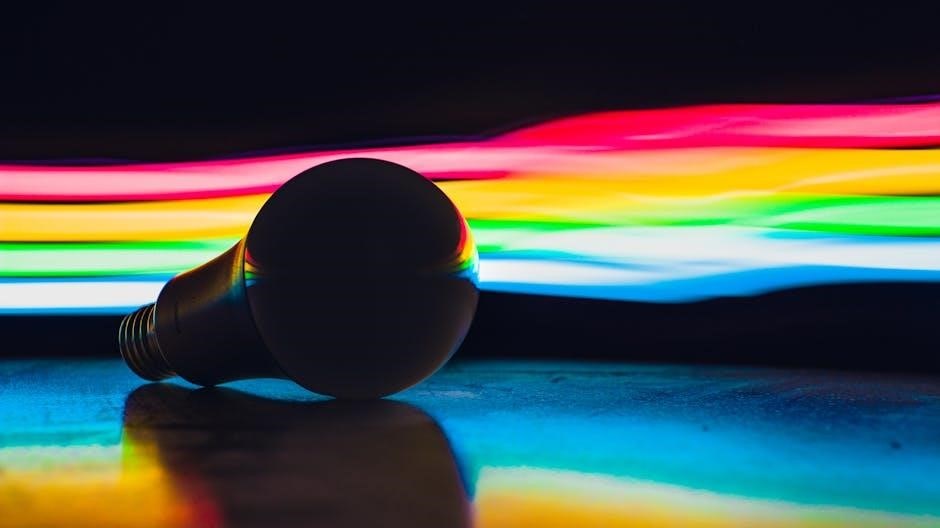Welcome to our comprehensive guide on light bulb colors! Understanding color temperature is key to creating the perfect ambiance and functionality in any space. From warm, cozy glows to bright, energizing lights, this guide helps you navigate the world of lighting options, ensuring you make informed decisions for your home or workspace.
1.1 Understanding Color Temperature in Lighting
Color temperature, measured in Kelvin (K), defines the light’s warmth or coolness. Lower Kelvin values (2700K-3000K) produce warm, yellowish tones, creating cozy spaces, while higher values (5000K-6500K) emit cool, bluish-white light, enhancing focus and energy. This scale helps balance aesthetics and functionality, ensuring the right ambiance for any room. Understanding color temperature is essential for selecting bulbs that align with your desired atmosphere and lighting needs.
1.2 Importance of Color in Lighting Design
Color plays a pivotal role in lighting design, influencing both functionality and aesthetics. Warm tones create intimacy, while cool tones enhance productivity. The right color temperature can highlight interior design elements, affect mood, and improve task performance. Balancing color and brightness ensures spaces are both visually appealing and practical, making informed bulb selection crucial for achieving desired ambiance and usability in any setting.
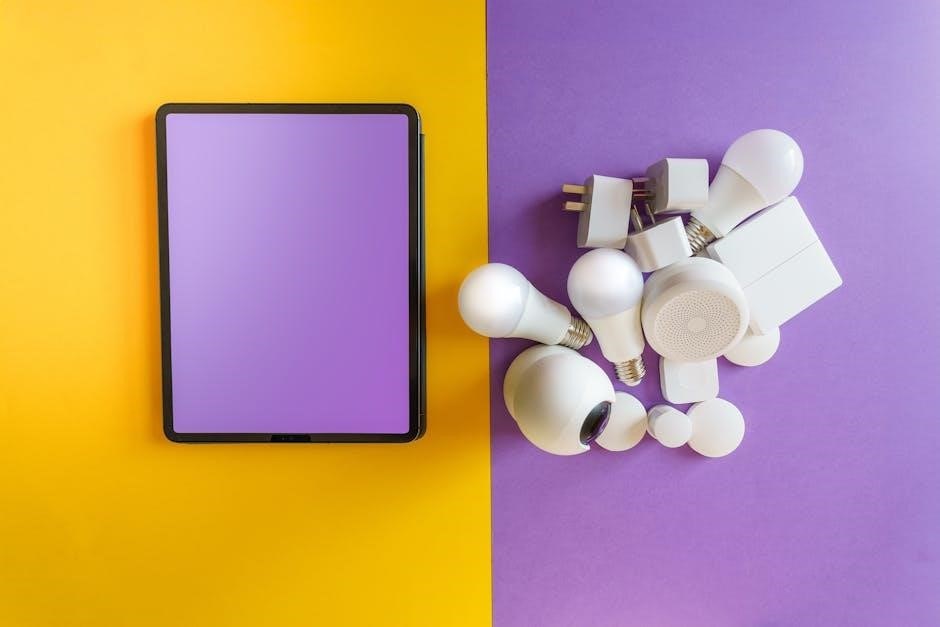
Color Temperature Basics
Color temperature, measured in Kelvin, defines a bulb’s light color. Lower Kelvin values produce warm, yellowish hues, while higher values yield cool, bluish tones, impacting ambiance and functionality.
2.1 What is Color Temperature?
Color temperature, measured in Kelvin (K), describes the light’s color appearance. Lower Kelvin values (e.g., 2700K-3000K) produce warm, yellowish tones, creating cozy spaces. Higher values (e.g., 5000K-6500K) emit cool, bluish light, ideal for task-oriented areas. This scale helps determine the ambiance and functionality of lighting, ensuring the right mood and visibility for different settings. Understanding color temperature is essential for selecting bulbs that align with your desired aesthetic and purpose.
2.2 Kelvin Scale and Its Significance
The Kelvin scale measures light bulb color temperature, ranging from warm (2700K-3000K) to cool (5000K-6500K). This scale reflects the bulb’s color appearance, influencing ambiance and functionality. Lower Kelvin values mimic warm daylight, ideal for cozy spaces, while higher values resemble natural daylight, enhancing clarity. Understanding the Kelvin scale helps in selecting the right bulb for specific tasks or aesthetics, ensuring optimal lighting for various settings and activities.
2.3 Warm White vs. Cool White Lighting
Warm white lighting (2700K-3000K) offers a soft, yellowish glow, creating a cozy and relaxing atmosphere, ideal for living rooms and bedrooms. Cool white lighting (3500K-5000K) provides a brighter, bluish tone, enhancing focus and energy, often used in kitchens and workspaces. The choice between warm and cool white depends on the desired ambiance and functionality, with warm white promoting relaxation and cool white fostering productivity.
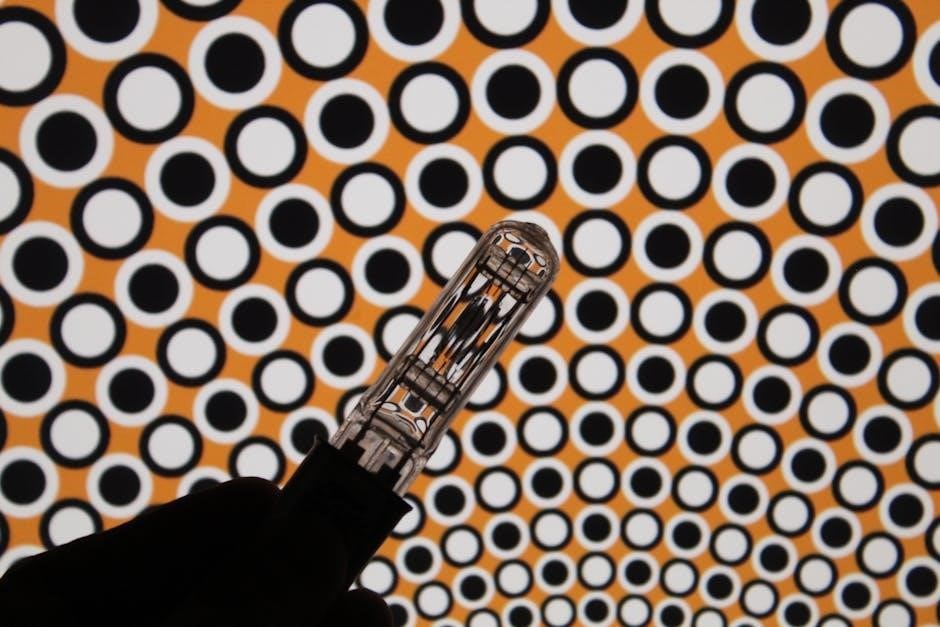
Types of Light Bulb Colors
Explore the spectrum of light bulb colors, from warm white to daylight, each offering unique ambiance and functionality. Color temperature in Kelvin guides your choice.
3.1 Warm White (2700K-3000K)
Warm white bulbs, ranging from 2700K to 3000K, emit a soft, yellowish light, creating a cozy and inviting atmosphere. Ideal for living rooms and bedrooms, this warm glow enhances relaxation. The lower Kelvin temperature produces a comforting ambiance, reminiscent of traditional incandescent lighting. Perfect for spaces where a calming, homey feel is desired, warm white bulbs are a popular choice for decorative and ambient lighting needs, blending seamlessly with classic and rustic interiors.
3.2 Soft White (3000K-3500K)
Soft white bulbs, ranging from 3000K to 3500K, offer a gentle, warm light with a slightly brighter tone than warm white. This range is ideal for spaces requiring a balance between ambiance and functionality, such as dining rooms or family areas. The soft glow complements traditional and modern decor, creating a welcoming atmosphere while providing enough light for daily activities. It’s a versatile choice for those seeking a warm yet slightly brighter illumination option.
3.3 Bright White (3500K-4100K)
Bright white bulbs, spanning 3500K to 4100K, provide a crisp, clean light with a neutral tone. This range is perfect for task-oriented spaces like kitchens, bathrooms, and workspaces, where clarity and focus are essential. Bright white lighting enhances visibility without harshness, making it ideal for reading, cooking, or detailed tasks. It strikes a balance between warmth and brightness, offering a versatile lighting solution that supports productivity while maintaining a pleasant environment.
3.4 Daylight (5000K-6500K)
Daylight bulbs, ranging from 5000K to 6500K, mimic natural daylight with a cool, bluish tint. Ideal for reading, task lighting, and outdoor spaces, they enhance clarity and focus. This range is perfect for areas requiring high visibility, such as workshops or garages. Daylight bulbs create an energizing atmosphere, reducing eye strain and promoting productivity. They are also great for showcasing true colors, making them a popular choice for spaces needing a bright, invigorating light.

Applications of Different Color Temperatures
Different color temperatures enhance ambiance and functionality across spaces. Residential areas benefit from warm tones for coziness, while commercial settings use cooler tones for productivity and clarity.
4.1 Residential Lighting
Residential lighting benefits greatly from tailored color temperatures. Warm white bulbs (2700K-3000K) create cozy, relaxing atmospheres, ideal for living rooms and bedrooms. Soft white (3000K-3500K) offers a balance, perfect for dining areas. Bright white (3500K-4100K) enhances task-oriented spaces like kitchens, while daylight bulbs (5000K-6500K) mimic natural light, ideal for reading or home offices. Choosing the right color temperature enhances comfort, functionality, and energy efficiency, ensuring your home feels inviting and meets your lifestyle needs.
4.2 Commercial Lighting
In commercial spaces, color temperature plays a crucial role in productivity and ambiance. Bright white (3500K-4100K) and daylight (5000K-6500K) bulbs are popular for offices, as they enhance focus and mimic natural light. For retail, warm white tones create inviting environments, while cool tones highlight merchandise. LEDs are favored for their energy efficiency and long lifespan, reducing maintenance costs. Tailoring color temperature to specific tasks ensures optimal functionality, making commercial lighting both effective and economical.
Technical Specifications of Light Bulbs
Technical specs like lumens, color rendering index (CRI), and wattage are crucial for selecting bulbs. These metrics ensure optimal brightness, color accuracy, and energy efficiency for your needs.
5.1 Lumens and Brightness
Lumens measure a bulb’s brightness, helping you choose the right light output for your space. Higher lumens mean greater brightness, while lower lumens provide softer lighting. Always check the lumen rating to ensure the bulb meets your needs for task, ambient, or accent lighting. Brightness also depends on the bulb’s wattage and efficiency, so consider both factors when selecting the perfect bulb for optimal illumination.
5.2 Color Rendering Index (CRI)
CRI measures how accurately a bulb renders colors, with higher ratings indicating better color representation. A CRI of 90+ is ideal, making colors appear vibrant and true-to-life. Bulbs with lower CRI may make colors look dull or washed out. LED bulbs often offer high CRI, enhancing visual clarity and creating a more natural lighting experience. Choose bulbs with high CRI for spaces where color accuracy is important, like living areas or workplaces requiring precise color perception.
5.3 Wattage and Energy Efficiency
Wattage indicates the energy a bulb consumes, while energy efficiency reflects how well it converts energy into light. LED bulbs are highly efficient, using significantly less wattage than traditional incandescent bulbs while providing comparable brightness. Higher efficiency means lower energy costs and reduced environmental impact. Always check the energy rating to ensure you’re selecting an eco-friendly option that balances brightness and energy savings for long-term benefits.
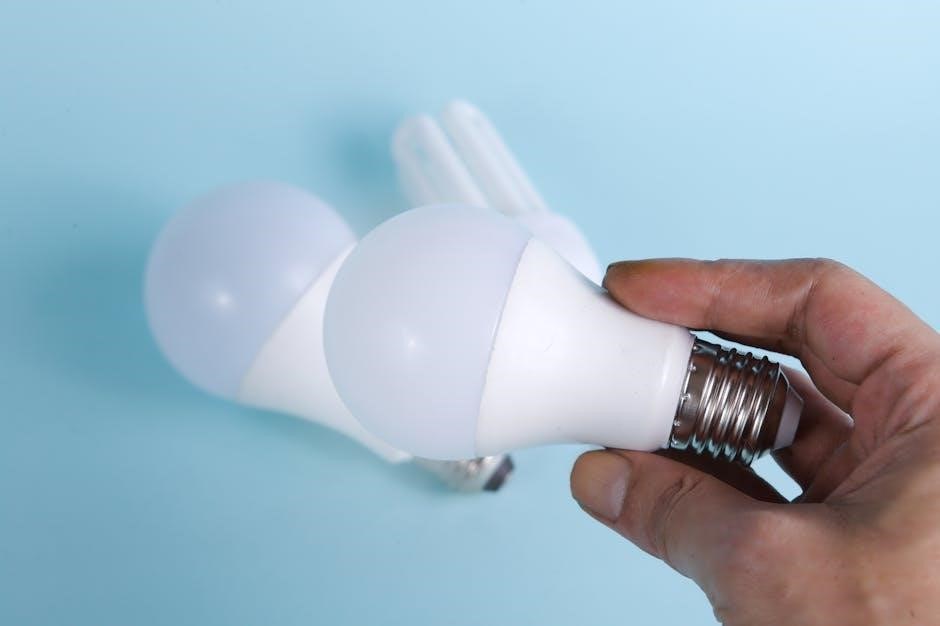
LED Bulb Color Guide
LED bulbs offer versatile color options, from warm white to daylight tones, enhancing ambiance and functionality. Their energy efficiency and long lifespan make them a top choice for modern lighting needs.
6;1 LED Color Temperature Options
LED bulbs are available in a wide range of color temperatures, from warm white (2700K-3000K) to cool daylight (5000K-6500K). This versatility allows users to choose the perfect ambiance for any setting, whether it’s a cozy living room or a bright, energizing workspace. With options to suit every need, LEDs provide both functionality and aesthetic appeal, ensuring optimal lighting solutions for various applications.
6.2 Dimmable LED Bulbs
Dimmable LED bulbs offer flexibility in lighting by allowing users to adjust brightness and ambiance. They are energy-efficient, long-lasting, and provide smooth dimming performance. These bulbs are ideal for creating customizable lighting environments, from soft, warm glows to brighter, more energizing settings. With compatibility with various dimmer switches, they enhance lighting control and visual comfort, making them perfect for both residential and commercial spaces.
6.3 RGB and Smart LED Bulbs
RGB and smart LED bulbs revolutionize lighting by offering vibrant color options and advanced connectivity. These bulbs use RGB technology to display a wide spectrum of colors, creating dynamic lighting effects. Smart bulbs integrate with home automation systems, allowing users to control color, brightness, and schedules via apps. They enhance ambiance, security, and energy efficiency, making them a popular choice for modern homes and innovative spaces.
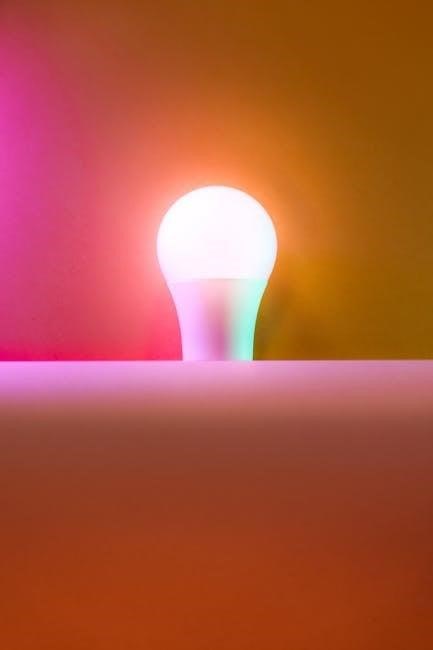
Specialized Lighting Solutions
Specialized lighting solutions offer unique color options for specific needs, including decorative, outdoor, and color-changing bulbs, enhancing ambiance and functionality while optimizing energy efficiency.
7.1 Decorative Lighting Colors
Decorative lighting colors enhance both style and ambiance, offering a wide range of options to suit various decors. Warm white bulbs (2700K-3000K) create a cozy, traditional feel, while soft white (3000K-3500K) provides a balanced, calming atmosphere. For modern spaces, daylight bulbs (5000K-6500K) deliver crisp, energizing light. Specialty colors, like blue or pink, add unique themes to rooms. The right color temperature can elevate aesthetics, making it essential to choose bulbs that align with your interior design goals for a harmonious and visually appealing environment.
7.2 Outdoor Lighting Color Options
Outdoor lighting color options vary to meet different needs and settings. Daylight bulbs (5000K-6500K) are ideal for security and task lighting, providing crisp, cool tones. Warm white bulbs (2700K-3000K) create a welcoming ambiance for pathways and gardens. Cool white options (3500K-4100K) offer a balanced, neutral light. Consider the desired mood and functionality when selecting outdoor lighting colors to enhance both safety and aesthetic appeal in your exterior spaces.
7.3 Color-Changing Bulbs
Color-changing bulbs offer versatility and dynamic lighting solutions. Using RGB technology or tunable white options, these bulbs allow seamless transitions between hues and brightness levels. Ideal for home decor, themed events, or ambient settings, they enhance creativity and convenience. Many are smart-enabled, controlled via apps for customization. Energy-efficient options, like LED color-changing bulbs, combine innovation with sustainability, making them a popular choice for modern lighting needs.
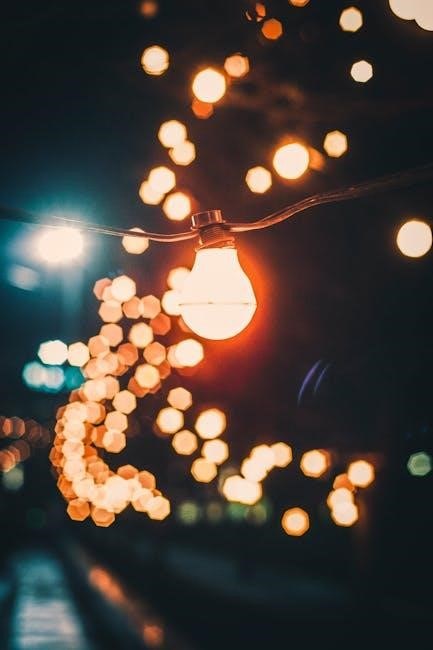
Energy Efficiency and Color
Energy-efficient lighting combines color quality and sustainability; LED bulbs offer high efficiency and long lifespan, while maintaining vibrant colors. Choose wisely to save energy without compromising on ambiance.
8.1 Energy Savings with LED Bulbs
LED bulbs offer significant energy savings, using up to 90% less energy than incandescent bulbs. Their long lifespan reduces replacement frequency, lowering overall costs. With high efficiency and reduced power consumption, LEDs are an eco-friendly choice. They maintain vibrant colors while minimizing energy use, making them ideal for both residential and commercial spaces. This energy efficiency contributes to lower utility bills and a smaller carbon footprint, aligning with sustainable living goals.
8.2 Environmental Impact of Lighting Choices
Lighting choices significantly impact the environment, primarily through energy consumption and waste. LED bulbs, being energy-efficient, reduce CO2 emissions and minimize environmental strain. Their longer lifespan also decreases e-waste compared to traditional bulbs.
In contrast, incandescent bulbs consume more energy, contributing to higher emissions. Opting for eco-friendly options like LEDs helps conserve resources and supports sustainable living. Always choose Energy Star-rated products and dispose of bulbs responsibly to further reduce environmental impact.
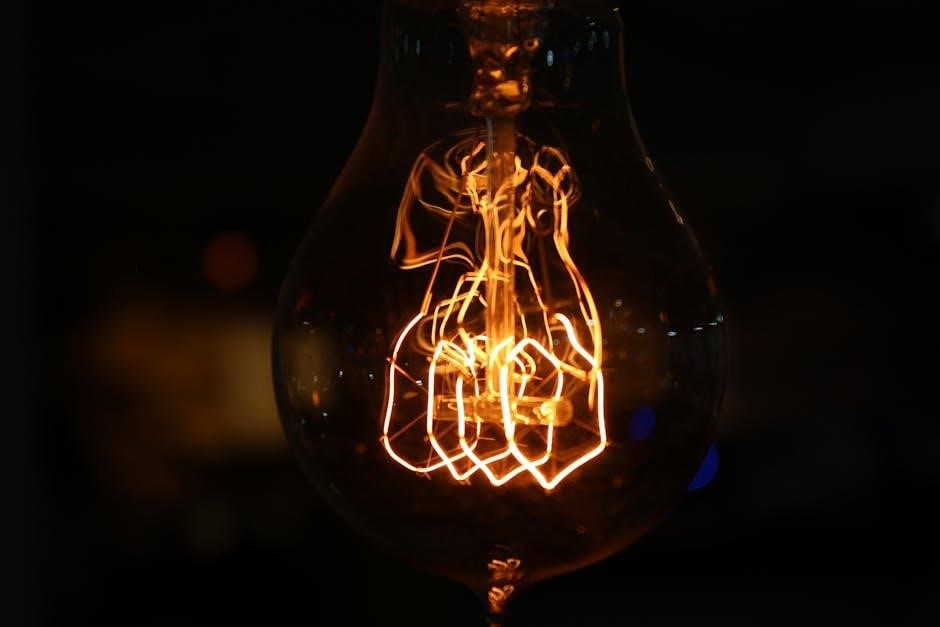
Choosing the Right Bulb Color
Selecting the right bulb color is crucial for ambiance and functionality. Consider color temperature to create desired environments, from warm coziness to bright productivity, tailored to your space and preferences.
9.1 Considering Room Size and Layout
Room size and layout significantly influence bulb color choice. Larger spaces benefit from cooler tones like daylight bulbs (5000K-6500K) for brightness, while smaller rooms thrive with warm whites (2700K-3000K) for coziness. Open layouts may require consistent lighting, while segmented areas can mix task and ambient lighting. Consider natural light sources and activity zones to tailor color temperatures, ensuring functionality and aesthetic harmony. This approach creates balanced, inviting environments suited to each room’s purpose and atmosphere.
9.2 Personal Preference and Aesthetics
Personal preference and aesthetics play a crucial role in selecting bulb colors. Warm white tones (2700K-3000K) create cozy, traditional vibes, while cool tones (3500K-5000K) offer modern, energizing atmospheres. Consider your decor style—warm whites complement rustic designs, whereas daylight bulbs enhance sleek, contemporary spaces. Color temperature should align with your desired mood, whether relaxing, productive, or elegant. Tailoring lighting to personal taste ensures spaces reflect individuality and enhance overall ambiance, making rooms feel uniquely yours.
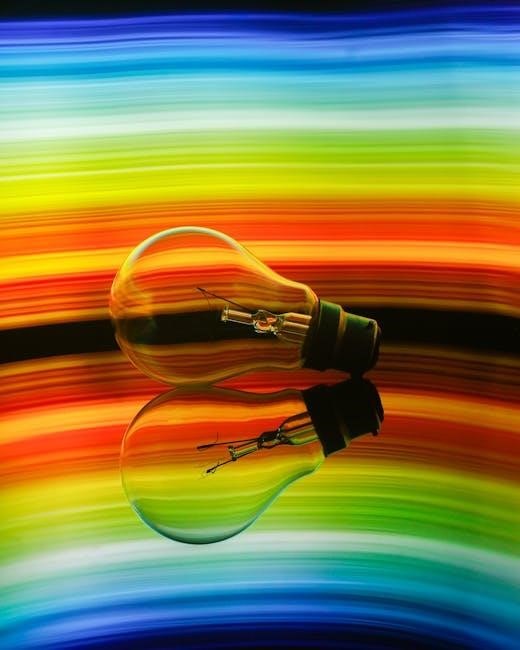
Maintenance and Lifespan
Proper care extends bulb lifespan. Avoid overheating, use dimmers correctly, and clean dust regularly. LED bulbs last longer than traditional options, offering durability and energy efficiency over time.
10.1 Lifespan of Different Bulb Types
The lifespan of light bulbs varies significantly by type. LED bulbs are the most durable, lasting up to 50,000 hours, while incandescent bulbs typically last 1,000-2,000 hours. Halogen bulbs offer a moderate lifespan of 2,000-4,000 hours. Energy-efficient options like CFLs can last up to 10,000 hours but may fade over time. Understanding these differences helps you choose bulbs that balance longevity, energy efficiency, and color quality for your specific needs.
10.2 Maintenance Tips for Optimal Color
To maintain optimal color, regularly dust bulbs and fixtures to prevent dimming. Avoid exposure to moisture and extreme temperatures, which can degrade color quality. Use compatible dimmers and avoid overheating to preserve color consistency. Replace bulbs when color begins to fade. Proper care extends color accuracy and enhances lighting performance. Check manufacturer recommendations for specific bulb types to ensure longevity and vibrant color output.
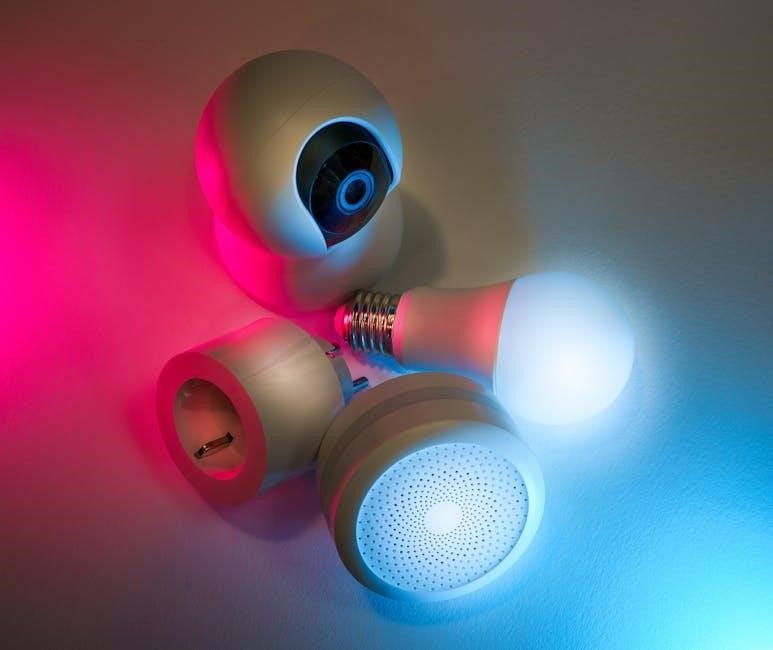
Troubleshooting Common Issues
Identify and resolve issues like flickering, dimming, or color inconsistency. Check connections, replace faulty bulbs, and ensure compatibility with fixtures and dimmers for optimal performance.
11.1 Flickering or Dimming
Flickering or dimming bulbs can be frustrating. Loose connections or faulty dimmers often cause this. Ensure all fixtures are securely connected and compatible with your bulbs. LED bulbs may flicker if dimmers aren’t optimized for them. Check for driver issues in LED bulbs and replace if necessary. Always verify bulb and fixture compatibility to maintain consistent lighting performance and avoid premature wear.
11.2 Color Inconsistency
Color inconsistency in bulbs can occur due to varying manufacturing tolerances or incorrect color temperature settings. Check if all bulbs are from the same batch and manufacturer. Ensure they share the same Kelvin rating for uniformity. If using smart bulbs, verify that color settings are synchronized across all bulbs. Additionally, ensure bulbs are compatible with your fixtures and dimmers, as mismatches can cause uneven lighting. Refer to manufacturer guidelines for optimal performance and consistent color output.
Understanding light bulb color temperatures and their applications is crucial for creating ideal lighting environments. Choose wisely based on room size, personal preference, and desired ambiance for optimal results.
12.1 Summary of Light Bulb Color Guide
This guide provides a comprehensive overview of light bulb color temperatures and their applications. It explains how different Kelvin ratings create distinct atmospheres, from warm, cozy spaces to bright, energizing environments. Key factors like lumens, CRI, and energy efficiency are explored, helping users make informed choices. Whether for residential or commercial use, understanding bulb colors ensures optimal lighting solutions. The guide also highlights LED options and future trends, empowering readers to select the perfect lighting for their needs.
12.2 Future Trends in Lighting Colors
Future lighting trends emphasize smart technology and energy efficiency. Smart bulbs with IoT integration will dominate, allowing color temperature adjustments via apps. Color-changing LEDs and tunable whites will gain popularity, offering dynamic lighting solutions. Advances in RGB technology will enable vibrant, customizable hues. Sustainability will drive demand for eco-friendly, recyclable materials. Expect higher CRI values for truer color representation. These innovations will redefine lighting, blending functionality with aesthetic appeal for smarter, greener living spaces.
